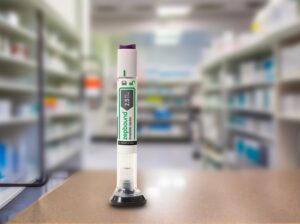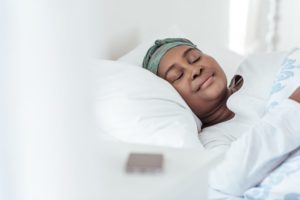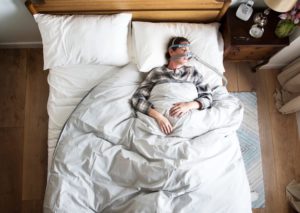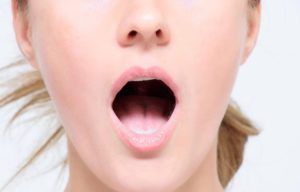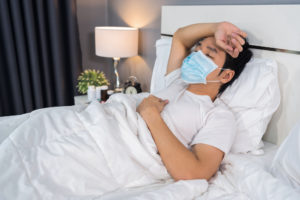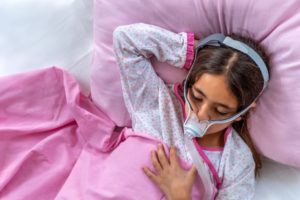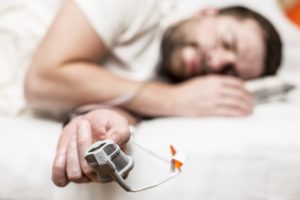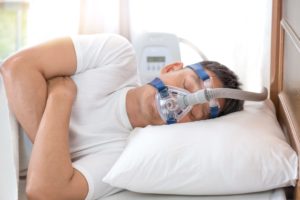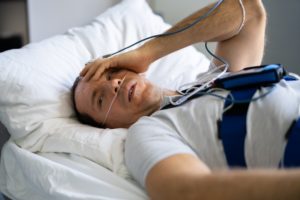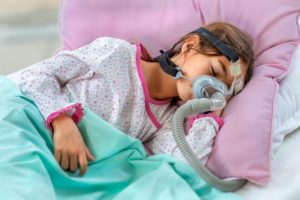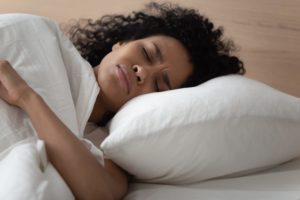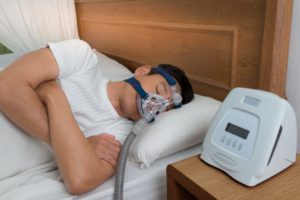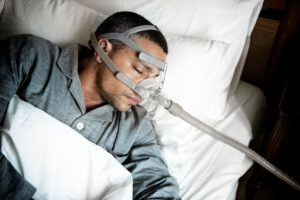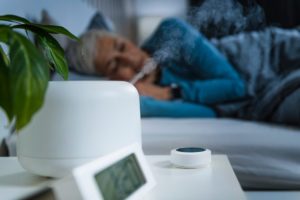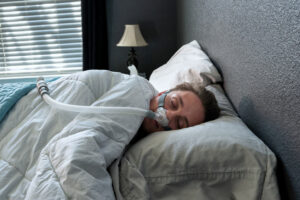Sleep Apnea in Infants and Newborns
Sleep is vital to a baby’s growth and development. Like other sleep disorders that occur in young children, sleep apnea can prevent newborns and infants from getting the necessary amount of quality sleep they need to thrive. If left untreated, severe apnea during infancy can result in long-term health complications.
Having knowledge about sleep apnea in babies can help parents and caregivers understand what symptoms to watch out for and when to contact a pediatrician. We take a closer look at the causes of sleep apnea in babies, as well as the symptoms, diagnosis, and treatment of this sleep-related breathing disorder.
What Is Sleep Apnea?
Apnea is a medical term used to describe brief lapses in breathing. Apnea is common in premature newborns, but can begin at any time during infancy. Babies may experience episodes of apnea while awake and during sleep.
To be diagnosed with sleep apnea, pauses in breathing must occur during sleep and last at least 20 seconds. Shorter lapses in breathing may be diagnosed as sleep apnea if they are accompanied by other symptoms such as a reduction in heart rate or bluish coloring of the skin.
There are two types of sleep apnea: obstructive and central.
- Obstructive sleep apnea (OSA): OSA happens when an infant’s throat narrows or closes during sleep. Babies with OSA try to inhale, but are unable due to an obstruction in their airway.
- Central sleep apnea (CSA): CSA is the result of irregular signals from the brain that disrupt a baby’s breathing patterns during sleep. Unlike OSA, infants with CSA do not attempt to inhale and there is no airway blockage.
Is Your Snoring a Health Risk?
Answer three questions to understand if you should be concerned.
What Causes Sleep Apnea in Babies?
Sleep apnea is most common in adults, but also affects children, infants, and newborns. Apnea during infancy is most common in babies with low birth weight and in those born prematurely.
Almost all infants born at less than 28 weeks of pregnancy experience apnea. Apnea occurs in 50% of infants born between 33 to 35 weeks of gestation and is rare in full-term infants.
Certain risk factors can increase the likelihood that a baby will develop sleep apnea. Importantly, not all babies that have a risk factor or a combination of risk factors will develop sleep apnea.
Risk Factors for Obstructive Sleep Apnea
There are a range of factors that can increase a newborn or infant’s risk of a blockage of the airway characteristic of obstructive sleep apnea (OSA).
- Small airway: Newborns and infants born with abnormalities in the structure of their face or head are at a higher risk for sleep apnea. Babies born with abnormalities in the upper airway , also called the larynx, may also be at an increased risk for OSA.
- Gastroesophageal reflux: Reflux can increase the likelihood that a baby will develop OSA. Gastroesophageal reflux in babies with abnormalities of the larynx can further compound the risk of OSA.
- Cleft palate: Babies born with a cleft palate may have a smaller airway and a heightened risk of OSA.
- Neuromuscular disorders: Certain disorders, such as Down syndrome and cerebral palsy, are known to increase the risk of OSA due to muscle weakness that causes the airway to collapse during sleep.
- Secondhand smoke: Exposure to secondhand smoke is associated with obstructive sleep apnea in infants and children.

Risk Factors for Central Sleep Apnea
In infants born prematurely, central apnea is often related to an underdeveloped brainstem. Infants and newborns are also sensitive to issues that can affect the brain’s respiratory center and cause central apnea. Factors that increase the risk of central sleep apnea include:
- Infections such as meningitis and pertussis
- Gastroesophageal reflux
- Head trauma
- Exposure to toxins
- Metabolic disorders
- Down syndrome and Arnold-Chiari malformation
Symptoms of Baby Sleep Apnea
The primary symptom of sleep apnea in infants and newborns is a pause in breathing that lasts for at least 20 seconds during sleep which may be observed by a caregiver. Although infants with less severe sleep apnea may have few or no visible symptoms, caregivers may notice one or several signs of apnea :
- Snoring
- Labored breathing
- Frequently waking during sleep
- Recurrent respiratory infections
- Mouth breathing
- Sweating during sleep
- Difficulty swallowing
- Developmental delays
Infants and newborns may have episodes of apnea that last less than 20 seconds and many symptoms of sleep apnea can also be seen in infants who do not have sleep apnea. For these reasons, caregivers with concerns about a baby’s sleep or breathing patterns should talk with a pediatrician.
How Is Sleep Apnea Diagnosed in Babies?
Doctors routinely monitor a newborn’s breathing rate and pattern within 24 hours after delivery . This examination may take place in the neonatal intensive care unit (NICU), nursery, or parent’s hospital room. Any breathing related concerns will be noted during this time, as will signs of congenital abnormalities that may increase the risk of breathing issues.
Once an infant leaves the hospital, caregivers can speak with the baby’s pediatrician about concerns related to breathing and sleep apnea. Doctors may ask about an infant’s symptoms, including breathing concerns, as well as family history and potential exposure to toxins in the home. In many cases, newborns and infants are referred to specialists to diagnose and determine the underlying cause of sleep apnea.
A range of tests may be considered depending on a baby’s symptoms. These tests may be performed to diagnose or rule out sleep apnea.
- Physical exam: Doctors perform a physical exam, though symptoms may not always be present at the time of the exam or may get worse under certain conditions.
- Polysomnography: A sleep study is the gold standard to confirm a diagnosis of sleep apnea in newborns and infants. Polysomnography can detail the various types of sleep apnea as well as its severity. It can also help doctors plan treatment and monitor a newborn or infant’s response to sleep apnea treatment.
- Airway endoscopy: Doctors may use a flexible tube with a camera attached to see a baby’s airway. This test is often used to determine the cause of sleep apnea to evaluate the location and severity of the condition.
- Imaging tests: Neck X-rays and computed tomography (CT) scans can be used along with other tests to help doctors get a visualization of the anatomy of the upper airway.
Treatments for Sleep Apnea in Babies
Treatment for sleep apnea in newborns and infants depends on several factors, including the severity of symptoms and presence of other medical conditions. Most preterm infants grow out of symptoms by the time they reach 44 weeks after conception.
If symptoms are unresolved, or if episodes are frequent or need additional care, treatment for sleep apnea is important to reduce the risk of complications such as a failure to thrive, cognitive issues, and cardiovascular conditions. Typically, the treatment of newborn and infant sleep apnea involves a team of medical specialists depending on the needs of the infant.
An underlying medical condition is usually the cause of central sleep apnea that does not resolve during infancy. In these cases, treatment of the identified medical condition may help resolve central sleep apnea and its symptoms.
Treatment for obstructive sleep apnea in infants with only mild symptoms may be supportive until symptoms resolve on their own. In babies that require additional support, a team of health professionals carefully weigh the risks and benefits of various treatment options, including supplemental oxygen, positive airway pressure (PAP) therapy, and surgery to remove anything obstructing the infant’s airway.

Still have questions? Ask our community!
Join our Sleep Care Community — a trusted hub of sleep health professionals, product specialists, and people just like you. Whether you need expert sleep advice for your insomnia or you’re searching for the perfect mattress, we’ve got you covered. Get personalized guidance from the experts who know sleep best.
References
6 Sources
-
National Institute of Neurological Disorders and Stroke. (2019, March 27). Sleep Apnea Information Page., Retrieved April 20, 2022, from
https://www.ninds.nih.gov/Disorders/All-Disorders/Sleep-Apnea-Information-Page -
UpToDate. (n.d.). Patient education: Sleep apnea in children (The basics). UpToDate.
https://www.uptodate.com/contents/sleep-apnea-in-children-the-basics -
Kondamudi, N. P., Krata, L., & Wilt, A. S. (2021, November 7). Infant apnea. In StatPearls. StatPearls Publishing., Retrieved April 20, 2022, from
https://www.ncbi.nlm.nih.gov/books/NBK441969/ -
Chandrasekar, I., Tablizo, M. A., Witmans, M., Cruz, J. M., Cummins, M., & Estrellado-Cruz, W. (2022). Obstructive sleep apnea in neonates. Children (Basel, Switzerland), 9(3), 419.
https://pubmed.ncbi.nlm.nih.gov/35327791/ -
Katz, E. S., Mitchell, R. B., & D’Ambrosio, C. M. (2012). Obstructive sleep apnea in infants. American Journal of Respiratory and Critical Care Medicine, 185(8), 805–816.
https://pubmed.ncbi.nlm.nih.gov/22135346/ -
McKee-Garrett, T. M. (2021, October 7). Assessment of the newborn infant. In R. Martin, T.K. Duryea. (Eds.). UpToDate.
https://www.uptodate.com/contents/assessment-of-the-newborn-infant


